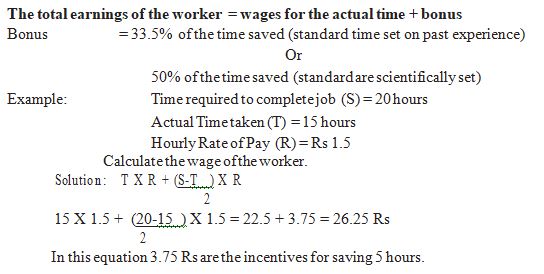Answer
Incentives can be classified under the following categories:
- Individual and Organizational Incentives
- Financial and Non-Financial Incentives
- Positive and Negative Incentives
- Individual and Organizational Incentives– According to L.G. Magginson, “Individual incentives are the extra compensation paid to an individual for all production over a specified magnitude which stems from his exercise of more than normal skill, effort or concentration when accomplished in a predetermined way involving standard tools, facilities and materials.” Individual performance is measured to calculate incentive where as organizational or group incentive involve cooperation among employees, management and union and purport to accomplish broader objectives such as an organization-wide reduction in labour, material and supply costs, strengthening of employee loyalty to company, harmonious management and decreased turnover and absenteeism
I) Individual Incentive System is of two types:
- Time based System- It includes Halsey Plan, Rowan Plan, Emerson Plan and Bedeaux Plan
- Production based System- it includes Taylor’s Differential Piece Rate System, Gantt’s Task and Bonus Plan
II) Group Incentive System is of following types
- Scalon Plan
- Priestman’s Plan
- Co-Partnership Plan
- Profit Sharing
Some important these plans of incentive wage payments are as follows:
Halsey Plan- Under this plan a standard time is fixed in advance for completing a work. Bonus is rewarded to the worker who perform his work in less than the standard time and paid wages according to the time wage system for the saved time.

Rowan Plan – Under this method minimum wages are guaranteed given to worker at the ordinary rate for the time taken to complete the work. Bonus is that proportion of the wages of the time taken which the time saved bears to the standard time allowed.
Incentive = Wages for actual time for completing the work + Bonus where,

Emerson Plan – Under this system, wages on the time basis are guaranteed even to those workers whose output is below the standard. The workers who prove efficient are paid a bonus. For the purpose of determining efficiency, either the standard output per unit of time is fixed, or the standard time for a job is determined, and efficiency is determined on the basis of a comparision of actual performance against the standard. Bedeaux Plan – It provide comparable standards for all workers. The value of time saved is divided both to the worker and his supervisor in the ratio of ¾ and ¼ respectively. A supervisor also helps a worker in saving his time so he is also given some benefit in this method. The standard time for each job is determined in terms of minutes which are called Bedeaux points or B’s. each B represents one minute through time and motion study. A worker is paid time wages upto standard B’s or 100% performance. Bonus is paid when actual performance exceeds standard performance in terms of B’s.
Taylor’s Differential Piece Rate System – F.W. Taylor, founder of the scientific management evolved this system of wage payment. Under this system, there is no guarantee of minimum wages. Standard time and standard work is determined on the basis of time study. The main characteristics of this system is that two rates of wage one lower and one higher are fixed. Those who fail in attaining the standard, are paid at a lower rate and those exceeding the standard or just attaining the standard get higher rate. Under this system, a serve penalty is imposed on the inefficient workers because they get the wages at lower rates. The basic idea underlying in this scheme is to induce the worker at least to attain the standard but at the same time if a worker is relatively less efficient, he will lose much. For example, the standard is fixed at 40 units per day and the piece rate are 40 P. and 50 P. per unit. If a worker produces 40 units or more in a day, he will get the wages at the rate of 50 P per unit and if he produces 39 units will get the wages at 40 paise per unit for the total output.
Gantt’s Task and Bonus Plan – In this, a minimum wage is guaranteed. Minimum wage is given to anybody, who completes the job in standard time. If the job is completed in less time, then there is a hike in wage-rate. This hike varies between 25% to 50% of the standard rate.
Profit Sharing – It is a method of remuneration under which an employer pay his employees a share in form of percentage from the net profits of an enterprise, in addition to regular wages at fixed intervals of time.
1) Financial and Non-financial Incentives- Individual or group performance can be measured in financial terms. It means that their performance is rewarded in money or cash as it has a great impact on motivation as a symbol of accomplishment. These incentives form visible and tangible rewards provided in recognition of accomplishment. Financial incentives include salary, premium, reward, dividend, income on investment etc. On the other hand, non-financial incentives are that social and psychological attraction which encourages people to do the work efficiently and effectively. Non-financial incentive can be delegation of responsibility, lack of fear, worker’s participation, title or promotion, constructive attitude, security of service, good leadership etc..
2) Positive and Negative Incentives- Positive incentives are those agreeable factors related to work situation which prompt an individual to attain or excel the standards or objectives set for him, where as negative incentives are those disagreeable factors in a work situation which an individual wants to avoid and strives to accomplish the standards required on his or her part. Positive incentive may include expected promotion, worker’s preference, competition with fellow workers and own ‘s record etc. Negative incentives include fear of lay off, discharge, reduction of salary, disapproval by employer
Total Views: 68
